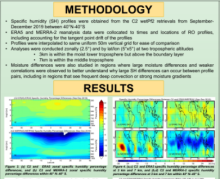Evaluation of Tropospheric Moisture Characteristics Among COSMIC-2, ERA5, and MERRA-2 in the Tropics and Subtropics
Benjamin
Johnston
UCAR
Poster
GNSS radio occultation (RO) receivers onboard the recently-launched COSMIC-2 (C2) satellite constellation provide an unprecedented number of high vertical resolution moisture profiles throughout the tropical and subtropical atmosphere. In this study, the distribution and variability of water vapor was investigated using specific humidity retrievals from C2 observations and compared to collocated ERA5 and MERRA-2 reanalysis profiles within 40N to 40S from September to December 2019, which is prior to assimilation of C2 in the reanalyses. Negative C2 moisture biases are evident within the boundary layer due to super-refraction of the RO signal, so we focus on levels above the boundary layer. Overall, C2 specific humidity shows excellent agreement with ERA5 and has larger differences with MERRA-2. In the tropical mid-troposphere, C2 shows positive biases compared to ERA5 (6-12%) and larger negative biases with MERRA-2 (15-30%). Strong correlations are observed between C2 and reanalysis specific humidity in the subtropics (>0.8) whereas correlations are slightly weaker in the deep tropics, especially for MERRA-2. Profile pairs with large moisture differences often occur in areas with sharp moisture gradients, highlighting the importance of measurement resolution. Locations with demonstrated weaker humidity correlations in active convection regions show that ERA5 has a negative specific humidity bias at 3 km in higher moisture environments whereas MERRA-2 displays large positive bias at 7 km. However, additional explanations for profile pairs with large moisture differences remain unclear and require further study.

Poster PDF